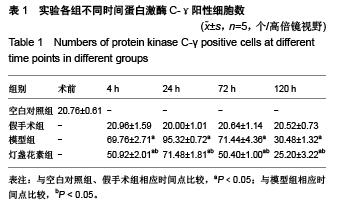| [1] Steinberg SF. Structural basis of protein kinase C isoform function. Physiol Rev. 2008;88(4):1341-1378.[2] Selvatici R, Falzarano S, Franceschetti L, et al. Differential activation of protein kinase C isoforms following chemical ischemia in rat cerebral cortex slices. Neurochem Int. 2006; 49(8):729-736.[3] Leenders AG, Sheng ZH. Modulation of neurotransmitter release by the second messenger-activated protein kinases: implications for presynaptic plasticity. Pharmacol Ther. 2005; 105(1):69-84.[4] Mellor H, Parker PJ. The extended protein kinase C superfamily. Biochem J. 1998;332 ( Pt 2):281-292.[5] 徐光,张礼萍,沈慧芬,等. 野黄苓甙元及其类似物对蛋白激酶C的抑制作用[J].上海医科大学学报, 1993, 20(3):187-191.[6] Newton AC. Protein kinase C. IUBMB Life. 2008;60(11): 765-768.[7] Koponen S, Goldsteins G, Keinänen R, et al. Induction of protein kinase Cdelta subspecies in neurons and microglia after transient global brain ischemia. Cereb Blood Flow Metab. 2000;20(1):93-102.[8] Kurkinen K, Keinänen R, Li W, et al. Preconditioning with spreading depression activates specifically protein kinase Cdelta. Neuroreport. 2001;12(2):269-273.[9] Wang J, Bright R, Mochly-Rosen D, et al. Cell-specific role for epsilon- and betaI-protein kinase C isozymes in protecting cortical neurons and astrocytes from ischemia-like injury. Neuropharmacology. 2004;47(1):136-145.[10] Ni TS, Wu SX, Li YQ. Localization of protein kinase Cγ subunit in rat nervous system. Acta Anatomica Sinica. 2002; 33(2):113-117.[11] Hughes AS, Averill S, King VR, et al. Neurochemical characterization of neuronal populations expressing protein kinase C gamma isoform in the spinal cord and gracile nucleus of the rat. Neuroscience. 2008 2;153(2):507-517.[12] Chou WH, Messing RO. Protein kinase C isozymes in stroke. Trends Cardiovasc Med. 2005;15(2):47-51.[13] Aronowski J, Labiche LA. Perspectives on reperfusion-induced damage in rodent models of experimental focal ischemia and role of gamma-protein kinase C. ILAR J. 2003;44(2):105-109.[14] Seki T, Takahashi H, Adachi N, et al. Aggregate formation of mutant protein kinase C gamma found in spinocerebellar ataxia type 14 impairs ubiquitin-proteasome system and induces endoplasmic reticulum stress. Eur J Neurosci. 2007; 26(11):3126-3140.[15] Suen PC, Wu K, Xu JL, et al. NMDA receptor subunits in the postsynaptic density of rat brain: expression and phosphorylation by endogenous protein kinases. Brain Res Mol Brain Res. 1998;59(2):215-228.[16] Hall KE, Browning MD, Dudek EM, et al. Enhancement of high threshold calcium currents in rat primary afferent neurons by constitutively active protein kinase C. J Neurosci. 1995;15(9):6069-6076.[17] 卢步峰, 鲁友明, 黄治森. 蛋白激酶C对大鼠缺血海马突触体谷氨酸摄取的调控作用[J].生物化学杂志,1994,10(3):371-374.[18] Lipton P. Ischemic cell death in brain neurons. Physiol Rev. 1999;79(4):1431-1568.[19] Joó F, Tósaki A, Oláh Z, et al. Inhibition by H-7 of the protein kinase C prevents formation of brain edema in Sprague-Dawley CFY rats. Brain Res. 1989;490(1):141-143.[20] 帅杰,董为伟. PKC抑制剂灯盏花素对缺血/再灌流脑损害的作用研究[J]. 中国药理学通报,1998,14(1):75-77.[21] Yang K, Taft WC, Dixon CE, et al. Endogenous phosphorylation of a 61,000 dalton hippocampal protein increases following traumatic brain injury. J Neurotrauma. 1994;11(5):523-532.[22] Sun FY, Faden AI. N-methyl-D-aspartate receptors mediate post-traumatic increases of protein kinase C in rat brain. Brain Res. 1994;661(1-2):63-69.[23] 陈康宁,董为伟,张帆. 蛋白激酶C激动剂PMA对培养神经元胞体内游离钙的影响[J]. 第三军医大学学报, 1997, 19(8):408-410.[24] Arundine M, Tymianski M. Molecular mechanisms of glutamate-dependent neurodegeneration in ischemia and traumatic brain injury. Cell Mol Life Sci. 2004;61(6):657-668.[25] Liu XW, Ma C, Xing RX, et al. The calmodulin-dependent protein kinase II inhibitor KN-93 protects rat cerebral cortical neurons from N-methyl-D-aspartic acid-induced injury.Neural Regen Res. 2013;8 (2): 111-120.[26] Manev H, Costa E, Wroblewski JT, et al. Abusive stimulation of excitatory amino acid receptors: a strategy to limit neurotoxicity. ASEB J. 1990;4(10):2789-2797.[27] Choi DW. Excitotoxic cell death. J Neurobiol. 1992;23(9): 1261-1276.[28] Schaphorst KL, Pavalko FM, Patterson CE, et al. Thrombin-mediated focal adhesion plaque reorganization in endothelium: role of protein phosphorylation. Am J Respir Cell Mol Biol. 1997;17(4):443-455.[29] Garcia JG, Verin AD, Schaphorst KL. Regulation of thrombin-mediated endothelial cell contraction and permeability. Semin Thromb Hemost. 1996;22(4):309-315.[30] 陈康宁,董为伟.灯盏花对脑缺血神经元凋亡的防治作用[J].中国临床神经科学,2000,8(1):5-7.[31] 余刚,罗勇,彭国光,等. 蛋白激酶C同工酶抑制剂对缺血/再灌注大鼠脑保护作用的实验研究[J].卒中与神经疾病, 2002, 9(6): 321-324.[32] 李俊彦,王东艳,杨金伟,等.灯盏花素干预体外培养大鼠脑皮质神经元的存活与生长[J].中国组织工程研究, 2014,18(20): 3196-3201.[33] 胡嘉航,陈海军,刘海洋,等.灯盏花素对大鼠出血性脑损伤的保护作用[J].神经解剖学杂志,2013,29(2):209-213.[34] 霍永强,谭源福.一种改进的落体脑创伤模型[J].广西医科大学学报,2007,24(2):217-219.[35] Cernak I. Animal models of head trauma. NeuroRx. 2005;2(3): 410-422.[36] Arrieta-Cruz I, Pfaff DW, Shelley DN. Mouse model of diffuse brain damage following anoxia, evaluated by a new assay of generalized arousal. Exp Neurol. 2007;205(2):449-460.[37] Vakili A, Kataoka H, Plesnila N. Role of arginine vasopressin V1 and V2 receptors for brain damage after transient focal cerebral ischemia. Cereb Blood Flow Metab. 2005;25(8): 1012-1019.[38] 梁楠,王仙凤,张晓.颅脑损伤动物模型的制备及评价[J].创伤外科杂志,2008,10(4):376-378. |


.jpg)
.jpg)
.jpg)
.jpg)